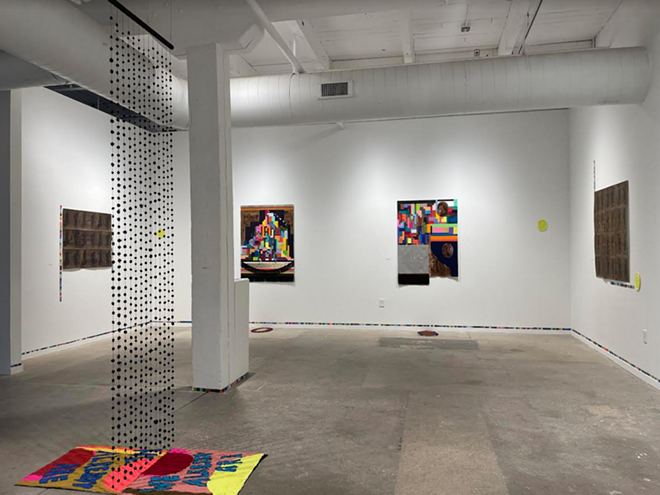SPACES Gallery Opens Back Up to the Public With Three Exhibitions
By Shawn Mishak on Tue, Apr 20, 2021 at 12:17 pm
[
{
"name": "Ad - NativeInline - Injected",
"component": "38482495",
"insertPoint": "3",
"requiredCountToDisplay": "5"
},{
"name": "Real 1 Player (r2) - Inline",
"component": "38482494",
"insertPoint": "2/3",
"requiredCountToDisplay": "9"
}
]
SPACES Art Gallery is open to the public again for the first time since the pandemic began with 3 exhibitions: “Back Back Forth and Forth,” “The Origin of Form” and “Coming Suddenly, Passing Strangely.”
“Reciprocity: Back Back Forth and Forth” features the work of artist-in-residence, Brooklyn-based artist, mother and activist, Mildred Beltré Martinez. Her work incorporates a number of techniques, processes and materials including integrating text, figure-based drawings, etching, weaving, cross-stitch, and beading. Martinez creates multimedia works which meditate on domesticity as a way of examining the cultural, social, and political implication of legibility.
Some of the pieces have similar elements and seem to refer to one another as the viewer begins to notice the repetition of patterns in the work. One piece by Beltré displays two small rugs which both read “We Already Are” and in-between these rugs is what looks like a beaded curtain but instead of beads, it is balls of human hair which she says she collected from members of her family. Beltré is the first of her family to be born in the US and her family originates from the Dominican Republic. The work speaks to her lineage and is a meditation on the past and future and how they intersect.
“The Back Back Forth and Forth I guess is also about time, thinking about the past and future, the reciprocity between those things…,” says Beltré. Her exhibition concludes with three cross-stich pieces, one of which she worked on with her mother and took over a year. They resemble something you might see on a throw pillow but contain phrases like: “REMEMBER YOU WILL DIE,” “We probably never had a chance at history,” and “THE WORLD DOES NOT BELONG TO US.” She hopes people find reciprocity in the work and then think about what resonates for them.
Another SPACES artist-in-residence, Martha Poggioli, has been developing her series on the history of reproductive devices and has partnered with the Dittrick Medical History Center and Sears think[box] at Case Western Reserve University in Cleveland to cultivate this collection of work. “The Origin of Form” exhibition consists of a wall map of all of the patents for intrauterine devices from 1867-2021, as well as handmade reproductions of devices ranging as far back as the Roman-era.
The viewer can examine the evolution of these objects which Poggioli has been cataloging since 2018.
“'The Origin of Form,' for me, encapsulates this idea around what it is to make a body and for a body to be configured through objects, so ‘industrial production,’” explains Poggioli. “There are a variety of formal logics that go through this history of objects that I’ve been tracking. The torus being one in terms of its logic and physics, for example, the toroidal space is this collapsing and expanding of the black hole and white hole and for me it’s kind of an interesting metaphor for production and reproduction.”
At age 32, Poggioli, who is from Brisbane Australia but lived in Melbourne for many years, has been in the states since 2017 when she moved to Chicago to attain her MFA from The Art Institute of Chicago. “Coming to the States, I’ve really arrived at my practice in many ways,” says Poggioli, who was trained in design but has had a studio practice for a very long time.
In addition to the mapping of these contraceptive devices, Poggioli’s fascination with the materials led her to recreate some of them during a residency with a partnership through the Kohler Company and the John Michael Kohler Arts Center in Wisconsin. She was originally supposed to be there for three month,s but because of COVID-19 she was ‘stranded’ there for eight months. Kohler provided her a studio and was able to introduce her reproductions into the production line at Kohler, which is the same company that began forging farming equipment, bathtubs and toilets in 1873.
A reproduction of a Roman-era pessary cast in bronze, which has two parts and basically looks like a little bagel, was one of the devices Poggioli made. A pessary is a prosthetic device that can be inserted into the vagina to support its internal structure. It can be used to treat urinary incontinence, vaginal or pelvic organ prolapse, or as a form of contraception. Poggioli says this also exists in the market today in the form of pink plastic.
“I hope people come here and discover something and begin to think through their relationship to these sorts of objects which are sort of prosthetically tethered to us,” says Poggioli. “I think it’s a very pretentious and nuanced history. We, as a society, should be talking about these sort of objects more often and the weird ethical and moral positions they put us in. So I hope that the show allows for discovery and conversation and I hope it allows for people arrive at new questions around their place in the world. We all come from the same site, this origin site, and I hope people to learn and enjoy this very strange history.”
Lastly, SPACES has added a new exhibition space which is a small room with a giant television in it, a couple of socially distant seats and an audio and video installation called “Coming Suddenly, Passing Strangely,” which was curated by SPACES’ Deputy Director Megan Young in a collaboration with Columbia College Chicago (CCC).
Tags:
SCENE Supporters make it possible to tell the Cleveland stories you won’t find elsewhere.
Become a supporter today.
Scroll to read more Cleveland News articles
Newsletters
Join Cleveland Scene Newsletters
Subscribe now to get the latest news delivered right to your inbox.














